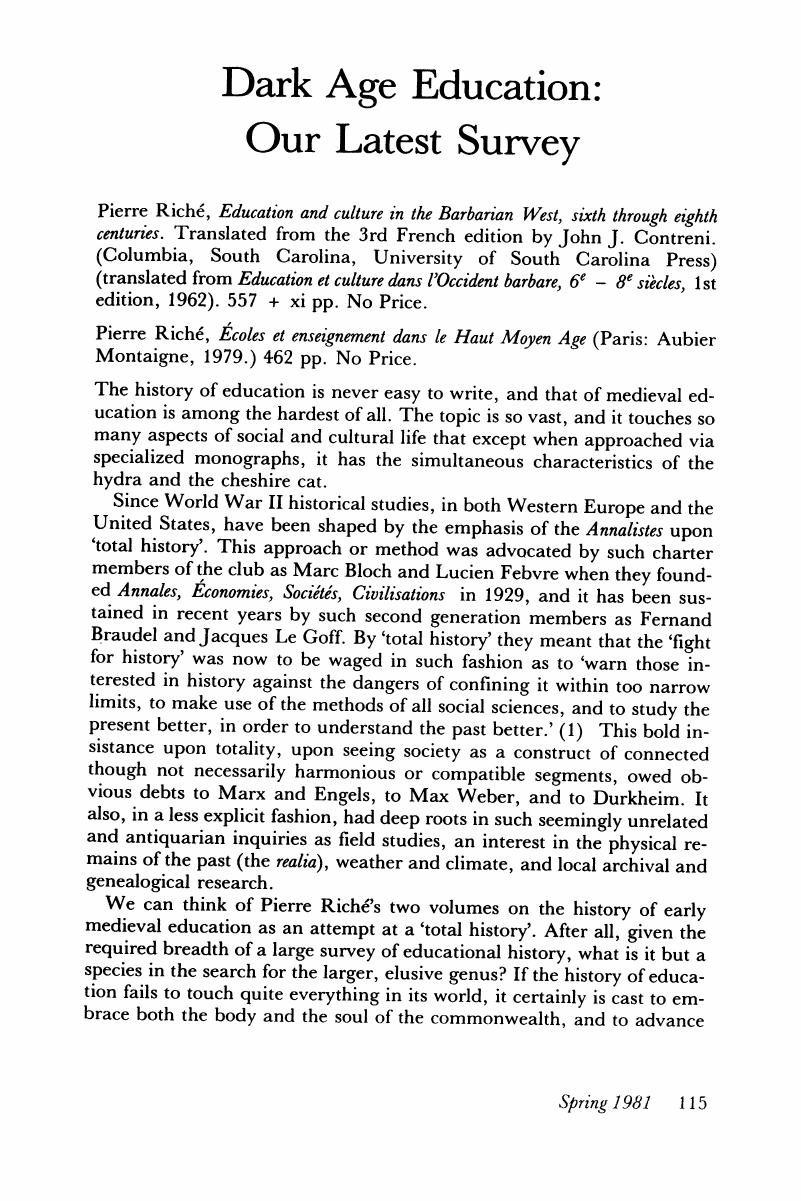No CrossRef data available.
Article contents
Dark Age Education: Our Latest Survey
Published online by Cambridge University Press: 24 February 2017
Abstract

- Type
- Essay-Reviews
- Information
- Copyright
- Copyright © 1981 by History of Education Society
References
Notes
1. Ferro, Marc, ed., Social Historians in Contemporary France (New York, 1972), from the ‘Foreward.’ Google Scholar
2. From John of Salisbury, The Policraticus , as quoted in The Portable Medieval Reader, ed., Ross, James B. and McLaughlin, Mary M. (New York, 1953), p. 48.Google Scholar
3. Haskins, Charles Homer, The Rise of Universities (Ithaca, 1957: reprint of 1923 edition), p. 25. The quotation is from Rashdall, Hastings, The Universities of Europe in the Middle Ages .Google Scholar
4. In the last 30 years Riché has written a number of general volumes: Grandes Invasions et Empires (1969); Les Invasions Barbares (1953); La Vie Quotidienne dans l'Empire Carolingien (1973), translated into English by McNamara, JoAnn, as Daily life in the World of Charlemagne (Philadelphia, 1978).Google Scholar
5. Particularly, Volume II, 102–10, 137–61, and 162–86. The maps (of which there are 13 in Volume I, 3 in Volume II) are cast in a rather simplistic fashion.Google Scholar
6. See Knowles, David, Great Historical Enterprises (London, 1963).Google Scholar
7. Translated, by Riché, , as documents 10 and 11, respectively: Volume II, 352–53. They are found in the Capitularia of the Monumenta Germaniae Historica .Google Scholar
8. Riché, Volume II, 129–30. See, de Fleury, Helgaud, Vie de Robert le Pieux, édité, traduit et annoté, Bautier, Robert-Henri & Labory, Gillette (Paris, 1965), and Rosenthal, J. T., ‘Edward the Confessor and Robert the Pious: 11th century Kingship and Biography’, Mediaeval Studies, 33 (1971): 7–20.Google Scholar
9. Treadgold, Warren T., ‘The Revival of Byzantine Learning and the Revival of the Byzantine State’, American Historical Review, 84 (1979): 1258, and 1259, respectively.Google Scholar
10. Taylor, Henry Osburn, The Mediaeval Mind (London and New York, 4th edition, 1925).Google Scholar
11. Artz, Frederick B., The Mind of the Middle Ages, a.d. 200–1500 (New York, 3rd edition, 1959). Gilson, Etienne, History of Christian Philosophy in the Middle Ages (New York, 1955); de Wulf, Maurice, Histoire de la Philosophic Mediévale (Louvain, 6th edition, 1934–37, 3 vols); Laistner, M. L. W., Thought and Letters in Western Europe, a.d. 500 to 900 (London, revised edition, 1957). There are also good short surveys available: Wolff, Philippe, The Awakening of Europe (Harmondsworth, 1968); and Knowles, David, The Evolution of Medieval Thought (New York, 1962).Google Scholar
12. Williams, Raymond, The Long Revolution (1961), and Hoggart, Richard, The Uses of Literacy (1957).Google Scholar
13. Bloch, Marc, Feudal Society (translated, Manyon, L. A.) (Chicago, 1964), xx.Google Scholar




